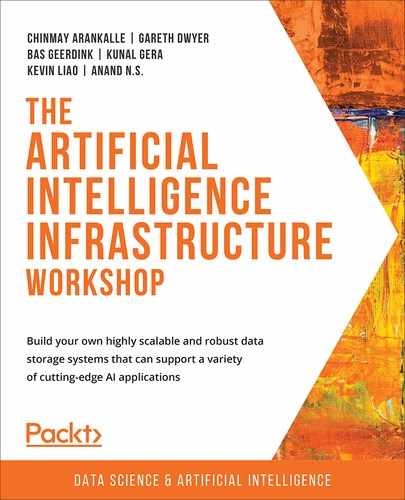The
ARTIficial Intelligence INfrastructure
Workshop
Build your own highly scalable and robust data storage systems that can support a variety of cutting-edge AI applications
Chinmay Arankalle, Gareth Dwyer, Bas Geerdink, Kunal Gera, Kevin Liao, and Anand N.S.
The Artificial Intelligence Infrastructure Workshop
Copyright © 2020 Packt Publishing
All rights reserved. No part of this course may be reproduced, stored in a retrieval system, or transmitted in any form or by any means, without the prior written permission of the publisher, except in the case of brief quotations embedded in critical articles or reviews.
Every effort has been made in the preparation of this course to ensure the accuracy of the information presented. However, the information contained in this course is sold without warranty, either express or implied. Neither the authors, nor Packt Publishing, and its dealers and distributors will be held liable for any damages caused or alleged to be caused directly or indirectly by this course.
Packt Publishing has endeavored to provide trademark information about all of the companies and products mentioned in this course by the appropriate use of capitals. However, Packt Publishing cannot guarantee the accuracy of this information.
Authors: Chinmay Arankalle, Gareth Dwyer, Bas Geerdink, Kunal Gera, Kevin Liao, and Anand N.S.
Reviewers: Brent Broadnax, John Wesley Doyle, Tim Hoolihan, Rochit Jain, Sasikanth Kotti, Asheesh Mehta, Arunkumar Nair, Madhav Pandya, Ashish Patel, Shovon Sengupta, and Ashish Tulsankar
Managing Editor: Ashish James
Acquisitions Editors: Manuraj Nair, Royluis Rodrigues, Kunal Sawant, Anindya Sil, Archie Vankar, and Karan Wadekar
Production Editor: Shantanu Zagade
Editorial Board: Megan Carlisle, Samuel Christa, Mahesh Dhyani, Heather Gopsill, Manasa Kumar, Alex Mazonowicz, Monesh Mirpuri, Bridget Neale, Dominic Pereira, Shiny Poojary, Abhishek Rane, Brendan Rodrigues, Erol Staveley, Ankita Thakur, Nitesh Thakur, and Jonathan Wray
First published: August 2020
Production reference: 1130820
ISBN: 978-1-80020-984-8
Published by Packt Publishing Ltd.
Livery Place, 35 Livery Street
Birmingham B3 2PB, UK
